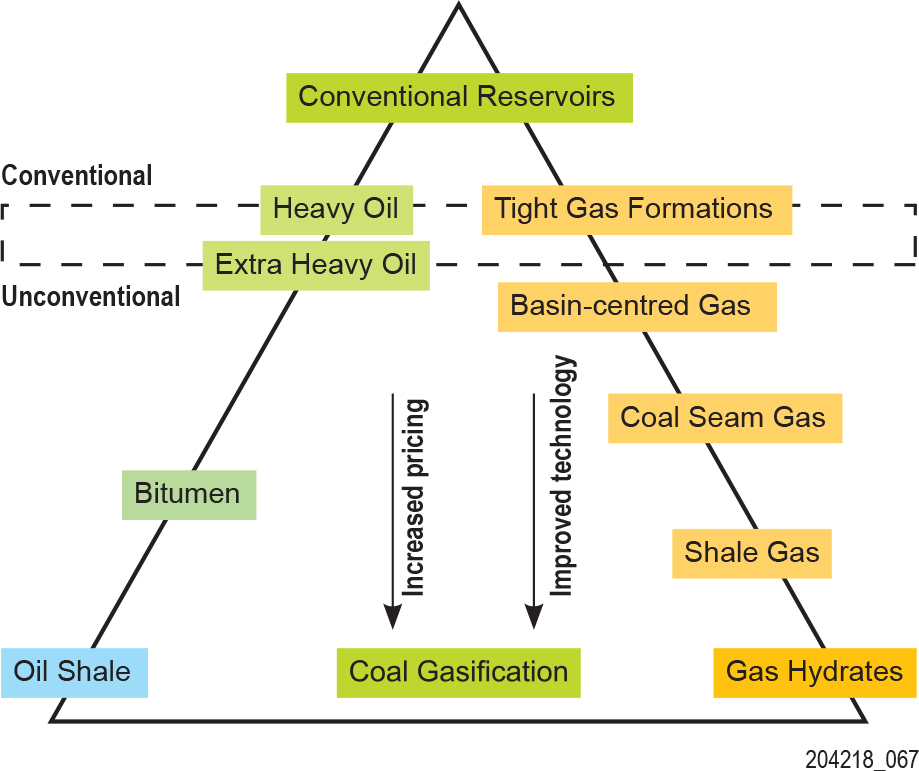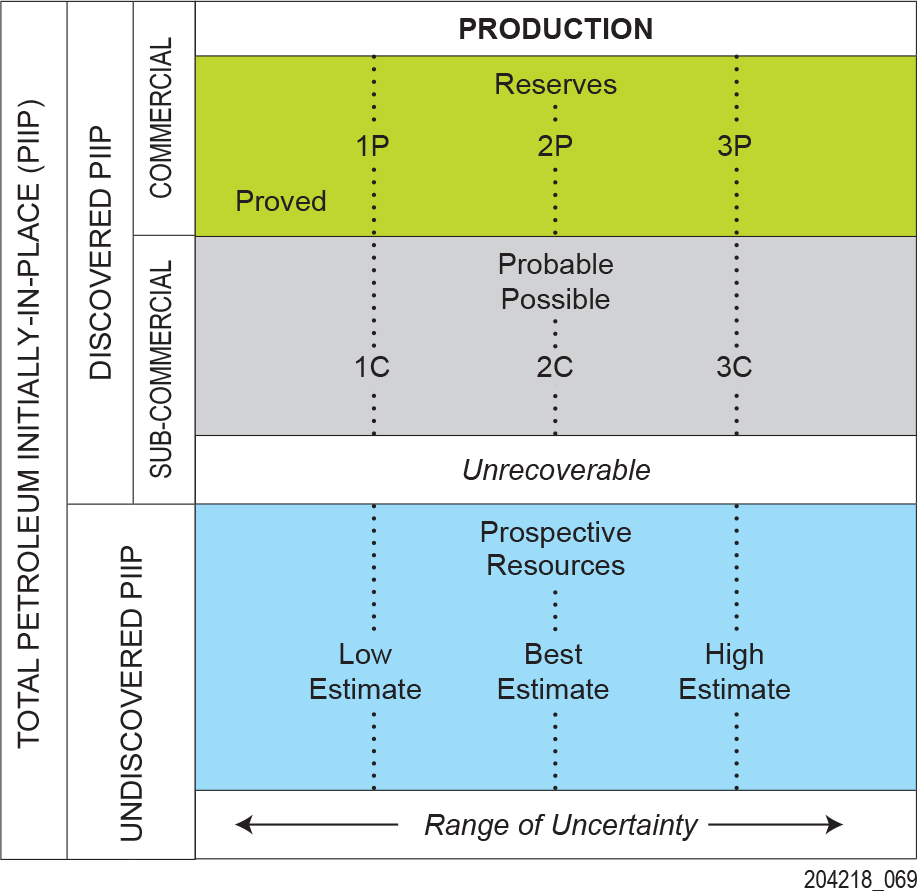On this page
Introduction
The Society of Petroleum Engineers (SPE1), American Association of Petroleum Geologists (AAPG2), Society of Exploration Geophysicists (SEG3), World Petroleum Council (WPC); and Society of Petroleum Evaluation Engineers (SPEE) have worked over many years to standardise the definitions of petroleum resources and how they are estimated, culminating in the jointly developed Petroleum Resources Management System (SPE-PRMS), the latest version published in 2018. The definitions and guidelines in the SPE-PRMS are designed to provide a common reference for the international petroleum industry. The Australian Security Exchange (ASX) reporting rules effective from 1 December 2013 are generally consistent with SPE-PRMS or provide additional clarification. The Glossary of Terms Used in Resources Evaluations included as Appendix A in the 2018 SPE-PRMS has therefore been adopted here, with minimal alteration.
Definitions
Two types of petroleum resources can be defined that may require different approaches for their evaluations – Conventional Resources and Unconventional Resources.
Conventional resources
Resources that exist in porous and permeable rock with buoyancy pressure equilibrium. The PIIP is trapped in discrete accumulations related to a localized geological structural feature and/or stratigraphic condition, typically with each accumulation bounded by a down dip contact with an aquifer, and is significantly affected by hydrodynamic influences such as buoyancy of petroleum in water.
Unconventional resources
Unconventional resources exist in petroleum accumulations that are pervasive throughout a large area and lack well-defined OWC or GWC (also called “continuous-type deposits”). Such resources cannot be recovered using traditional recovery projects owing to fluid viscosity (e.g., oil sands) and/or reservoir permeability (e.g., tight gas/oil/CBM) that impede natural mobility.
Examples include coal seam gas (CSG4), basin-centred gas, shale gas, gas hydrate, natural bitumen (tar sands), and oil shale deposits. Typically, such accumulations require specialised extraction technology (e.g. dewatering of CBM, massive fracturing programmes for shale gas, steam and/or solvents to mobilise bitumen for in situ recovery, and, in some cases, mining activities). Moreover, the extracted petroleum may require significant processing prior to sale (e.g. bitumen upgraders).
Very large volumes of petroleum exist in unconventional reservoirs, but their commercial recovery often requires a combination of improved technology and higher product prices.
A more detailed description of the unconventional gas resource categories, including shale gas, tight gas, coal seam gas and coal gasification, is referenced in the Glossary.

Figure 1. Resource Triangle - modified from Chan (2011) and Holditch (2009)
The relationship of unconventional to conventional resources can be illustrated in a resource triangle, as shown in Figure 1, modified from the figure published by Chan (2011) in the SPE Guidelines for the Application of the Petroleum Resources Management System. Heavy oil and tight gas formations straddle the boundary; nonetheless, both present challenges in applying the assessment methods typically used for conventional accumulations. Unconventional gas resources are shown down the right side of the triangle, and can be divided into two broad types: those in which gas has been generated by natural thermogenic and/or biogenic processes; and those in which gas (synthesis gas) is synthetically generated underground or in a surface plant with a thermo-chemical process.
Coal gasification has been added to the base of the triangle as suitable coals can be converted to synthesis gas (‘syngas’) either underground (in situ) or through mining and surface processing. Synthesis gas can then be further processed to manufacture high value synthetic diesel (liquid synfuel) and fertilizer. Oil shale and coal gasification resources differ from the other unconventional gas resources in that the enhancement of host rock reservoir quality through either de-pressurisation (as for shallow coal seam gas) or hydraulic fracture stimulation (as for shale gas, shale oil and CSG) is not the key to yield significant volumes of synthesis gas. Rather, thermal energy is the key to creating synthesis gas from oil shale and coal gasification.
Classification framework
The SPE-PRMS resources definitions, together with the classification system, are intended to be appropriate for all types of petroleum accumulations regardless of their in-place characteristics, extraction method applied, or degree of processing required. Consequently, both unconventional and conventional resources share the same classification framework for petroleum resources:

Figure 2. Resources Classification Framework
(SPE, 2018 – Petroleum Resources Management System (SPE-PRMS))
Those quantities of petroleum estimated, as of a given date, to be potentially recoverable from undiscovered accumulations by application of future development projects.
A chance of discovery and a chance of development are both associated with Prospective Resources.
Those quantities of petroleum estimated, as of a given date, to be potentially recoverable from known accumulations by application of development projects, but which are not currently considered to be commercially recoverable owing to one or more contingencies.
For unconventional reservoirs, the accumulation may be classed as ‘Discovered’ based on evidence other than a flowing well test (e.g. sampling and/or logging). A ‘Discovered’ resource type may be identified in very large areas from the results of prior drilling and the use of analogues to determine production potential.
Those quantities of petroleum anticipated to be commercially recoverable by application of development projects to known accumulations from a given date forward under defined conditions. Reserves must satisfy four criteria: they must be discovered, recoverable, commercial and remaining (as of the evaluation date) based on the development project(s) applied.
Typically, an unconventional resource can be classified as a Reserve after pilot programs have confirmed the technical and economic potential of a project(s). Reserves should be allocated once capital has been assigned for development.
Footnotes and references
1 The SPE is the peak international professional representative body for petroleum engineers. The SPE has a very active local branch in South Australia.
2 The AAPG is the peak international professional representative body for petroleum geologists The Petroleum Exploration Society of Australia (PESA) is the AAPG’s local affiliate. PESA has a very active local branch in South Australia.
3 The SEG is the peak international professional representative body for exploration geophysicists. The Australian Society of Exploration Geophysicists (ASEG) is the SEG’s local affiliate. The ASEG has a very active local branch in South Australia.
4 CBM is synonymous with coal seam methane (CSM) and coal seam gas (CSG). CSG is the more widely used term in Australia.
Australian Security Exchange (ASX), 2013: Reporting on Oil & Gas Activities, ASX Listing Rules Guidance Note 32
Chan, P., 2011: Unconventional Resources Estimation – Introduction, Chapter 8 in Guidelines for the Application of the Petroleum Resources Management System, Society of Petroleum Engineers, November 2011, pp128-161.
Society of Petroleum Engineers, 2018: Petroleum Resources Management System (SPE-PRMS)


